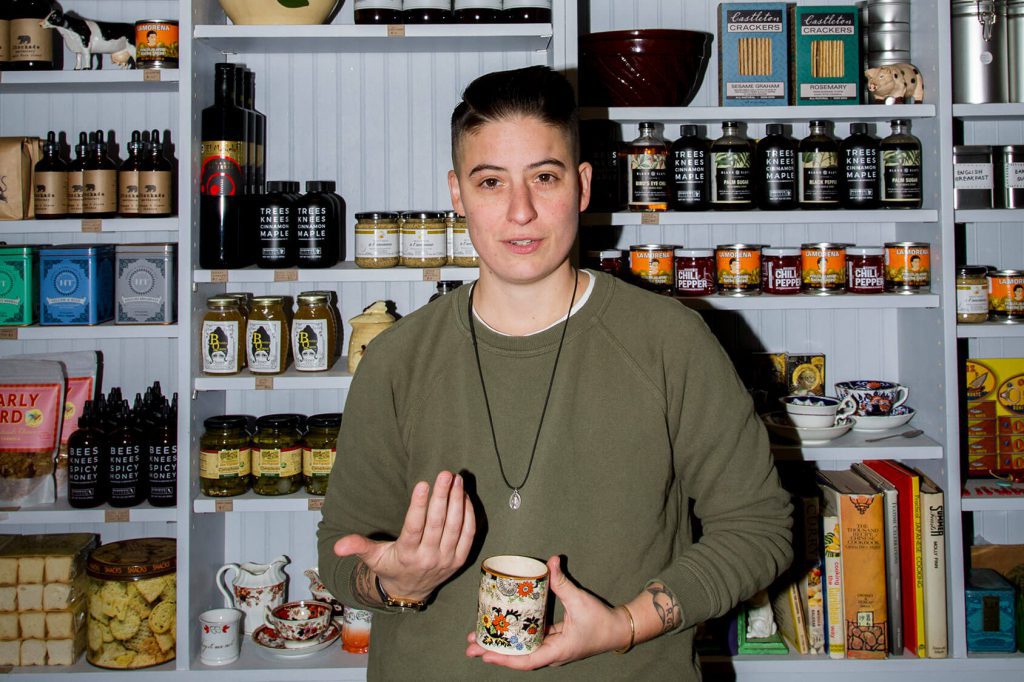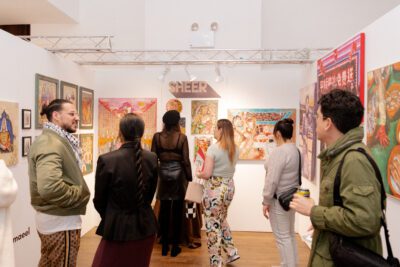At Bindle & Keep, Caring for Bodies through Bespoke, Gender Non-conforming Suits
In 2010, after years spent navigating the cis/straight menswear scene as a transmasculine person, New York native Rae Tutera had an epiphany. Inside a tailor shop in Manhattan, Tutera reconnected with their body while getting fit for a custom suit. Noting the frustration in finding clothes for both trans and gender nonconforming people, Tutera approached former architect and cis male suit maker Daniel Friedman in hopes of deconstructing this narrative. But these modest ambitions turned quickly into full-time careers with the formation of Bindle & Keep, a bespoke clothier who caters to LGBTQ and underserved communities. Tutera and Friedman were subjects of the 2016 Lena Dunham produced HBO documentary Suited, chronicling several Bindle & Keep customers seeking garments congruent with their identities.
Over beers at Swell Dive in Brooklyn, Tutera speaks humbly of the film’s success, but is far more invested in the current state of affairs. As Trump Administration rulings threaten the wellbeing of vulnerable communities, Tutera continues to resist fear and assist love. Tutera is all smiles when describing the creation of subsidized suits for Gavin Grimm, the seventeen year old transgender boy seeking to use school bathrooms that align with his gender, as well as members of the Innocence Project. With their mother-in-law Barbara Lester, Tutera also co-owns Willoughby General, a general store meets community space in the heart of Bed-Stuy. A remarkable listener, Tutera is a steadfast reminder of the importance of being present both in body and mind. Read our conversation below.
How did it feel to have Suited come out amidst the national conversation about transgender rights?
It took two years to make the documentary. We really didn’t know where in time it would land or what cultural moment it would be a part of. As we were making it, I kept getting the sense, and so did the other subjects (my clients, my friends), that it was becoming more and more relevant. That scared me because that meant that we had an even greater task to communicate our humanity. I’m not the producer or the director so I didn’t have control over the narratives or the structure of the documentary. It was a very stressful experience for it to align in the way it did. It came out in June—so maybe not at the most urgent moment because there will be so many urgent moments in trans rights.
Had I not gone around with the documentary to film festivals, I wouldn’t have had the context I was able to have. I would have felt a lot of hard feelings and criticisms about the film even though I think it’s a beautiful movie and does a real service to trans folks and gender nonconforming folks. I discovered at the exact moment that we are making our movie and releasing it that all these others folks are making movies that balance the context we were providing. Movies about homelessness, movies only about people of color. Being a part of that landscape made me feel better. Realizing that we weren’t just this documentary about suits. Which in many respects it’s a serious movie, and in many others it’s a movie about clothes. Particularly about a niche clothing company that caters to people who can afford it. It was refreshing to know that we had a place in that family of documentaries that were addressing all these different facets of trans life.
Has the documentary taken on new meaning since the Trump Administration decided to reverse the protections Obama put in place for trans students?
No—I don’t think about the documentary at this moment in time. It’s been eclipsed by so many different things. Now the urgency is to protect trans children. Gavin Grimm is one of my clients now. We just made him a free suit to wear to the Supreme Court.
What scares you the most about the recent rulings?
You as an educator, an ally, and me as an adult trans person—we can look at the guidelines being rescinded and try to make sense of it even though it’s evil and cruel. We know how to look at it and how to dismantle it in the work that we do and the lives that we lead. The scariest part of that is that children can’t do that. Children are bright and can contextualize things and can persevere, but the most worrisome thing for me here is that the message they may be getting is not only do they not have equal value to their classmates, but the government is bullying them in some capacity. That scares me, them not having the resources to know that it’s not okay.
What can parents, teachers, administrators, etc. do to send the message that we have students’s backs?
It’s a really important but also really difficult question. The truth is I’m just an adult who imagines being in these situations. In my experience a lot of queer and trans people have online communities. I don’t know many kids in reality because I’m 31 and I don’t have kids and my friends don’t have kids that are older than babies. And I’m not an educator. My participation is to demonstrate my solidarity with kids online. I have pen pals that are in high school all over the world. In lieu of or in addition to their communities, I tell them that they are living through something that I’ve lived through a version of and I’ve become an adult and have a good life and they are entitled to the same thing and inevitably it will happen. They were born more recently and they will enjoy the fruits of everyone’s labor to live in a better universe.
The Gay Straight Alliance at my school has been invaluable in reinforcing that message.
You can’t underestimate the importance they have. Showing up for kids in any capacity is important. Especially physically being present. I went to a GSA at Williamsburg Prep. It was depressing in some ways because teenagers are from the future now. They know so much more now than what any of us ever knew when we were tennagers. Maybe I’m romanticising them, but it was depressing to realize that they were encountering a lot of the same problems that I did twenty years ago.
One of your goals when Suited came out was to bring the film to schools around the country. Have you had that opportunity?
I haven’t done a screening at a school yet, which probably sounds crazy. I’m sure that it’s been shown at schools but I don’t know if people realize I would actually show up! I’m going to a boarding school in April to give a talk connected to the film—it will be shown to the students beforehand. I will say I’ve been in spaces at film festivals where the documentary was being screened in collaboration…usually their are hosts or sponsors and our film has been sponsored by GSAs countless times. In the front row inevitably at these screenings are kids from the GSAs and you go for the Q&A afterward and we would be looking them straight in the eye with this sense of awe that they find comfort in this. And as much as the suits and masculinity can be alienating, I think kids see it and they see us as adults and they see that it allows them to imagine their own future. To create any space in their minds that they have futures is the best work anyone can do. That’s what teaching is, too—it’s giving people the imagination and hope that they can do things. Not just now, but always.
Transgender icon Janet Mock calls the bathroom decision “the great equalizer”— is that an accurate way to put it?
I had the terrifying honor of going on CNN just a week ago. I thought they wanted to talk about Gavin being our client, anecdotes about him. I was meditating on all of these stories about Gavin and his strength and his intelligence. That he is our newest civil rights leader. Then of course they didn’t ask me anything about Gavin, they just asked me straight up about the bathroom drama—which is fair, because that is what it’s all attached to. I got to meditate on the same things Janet Mock and Laverne Cox have spoken to, which is that it is about more than bathrooms. Bathrooms are just a symbol of the fact that whether folks know it or not… when they debate whether transgender folks or gender nonconforming folks have the right to use the bathroom that they want to use, the truth is they are debating whether or not those folks can participate in public life. Going to the bathroom is an absolute essential thing we need to do when we are at work or at school, when we are doing our groceries, when meeting friends for a drink, when you are on a team at school.
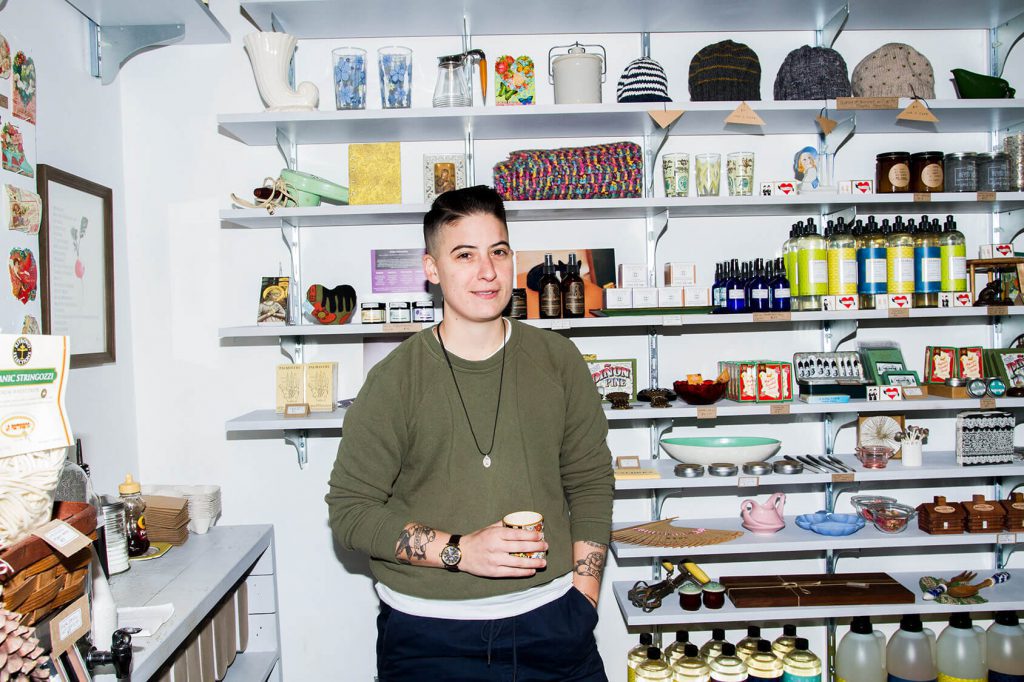
How does the focus become so narrow?
A lot of folks have compared bathrooms to water fountains. Having segregated water fountains. It was never really about water fountains. Again it was about whether black people could participate in public life and part of participating in public life is being hydrated. People who fear or despise black people or transgender people or gender nonconforming people, they find very strategic ways to exclude us. They come for our basic rights. A lot of people think how are bathrooms an issue? That’s what my family always says. My family aren’t social justice people, they are regular people and they ask me what does this have to do with bathrooms? A lot of people who aren’t narrow-minded in any way can’t understand how this relates to restrooms or they couldn’t imagine how it related to drinking fountains. That’s because they can’t imagine what it feels like to have this hatred or ignorance tucked away inside your consciousness or your perspective.
You’ve said the biggest challenge in 2016 would be POC and feminine identities bearing the brunt of the backlash against queer and trans rights? Is this true of 2017?
Yeah, it is. POC and feminine folks continue to bear the brunt of the discrimination. More than that, they lead us. They suffer the most and then they guide us. It’s a lot of responsibility for their own sort of healing and perseverance, but also guiding our collective sense of justice. They do that work, too.
Shannon Minter—the legal director for the National Center for Lesbian Rights—has said it’s a double whammy for transgender women of color, grappling with both transphobia and racism.
It’s crushing. And these are folks that help us find our moral compass and what we can actually do to evolve the elements. They are doing all of the work. We are following in their footsteps.
The efforts to keep trans people and gender nonconforming people out of rest rooms and out of public places is part of a much larger effort to do that. There are systemic ways that we are denied housing and jobs. All of them are tied together. If you can’t have a job, if you can’t go to school, if you can’t get an apartment, if you can’t go to the bathroom, do you exist? Do you get to exist? Aside from within your own community where you find joy and safety. You don’t really exist otherwise. That is a deliberate thing that some folks are pushing for. It’s a well rounded attack. It’s not just bathrooms. It’s a variety of different things that are stealing time from folks who have nothing but potential.
When you started at Bindle & Keep you guided your business partner on how to speak to people outside of his comfort zone. What was your advice to him?
Thankfully there was an exchange of lessons. Daniel was teaching me about tailoring. I wouldn’t heave learned how to make clothes for people if he wasn’t passing on his knowledge. I was teaching him about people with diverse genders. I don’t want to say I had the harder job, but I probably had the harder job. It’s much more delicate. A lot of people have been put in his position. It’s hard to know when you are supposed to educate versus when to feel like someone should already know something. You don’t want to be condescending, but you also want them to feel like they know what they’re doing. Every time we did a fitting there was a new learning curve introduced. Every fitting and every client is so different.
Would you find yourself getting frustrated?
Not frustrated, just worried. This is the same thing as me learning how to take measurements on real people. Practicing being an ally and practicing being a tailor on people are two very high stakes jobs. Daniel and I both had our work cut out for us. I didn’t want to make someone clothes that made them feel the way department clothes stores made them feel. The last thing I would want is for someone to feel like their bodies weren’t right in some way. And Daniel, the last thing he wanted was to alienate someone for how they felt when they went to a department store. We were figuring it all out. Our clients were patient and merciful. They knew that we were well intentioned.
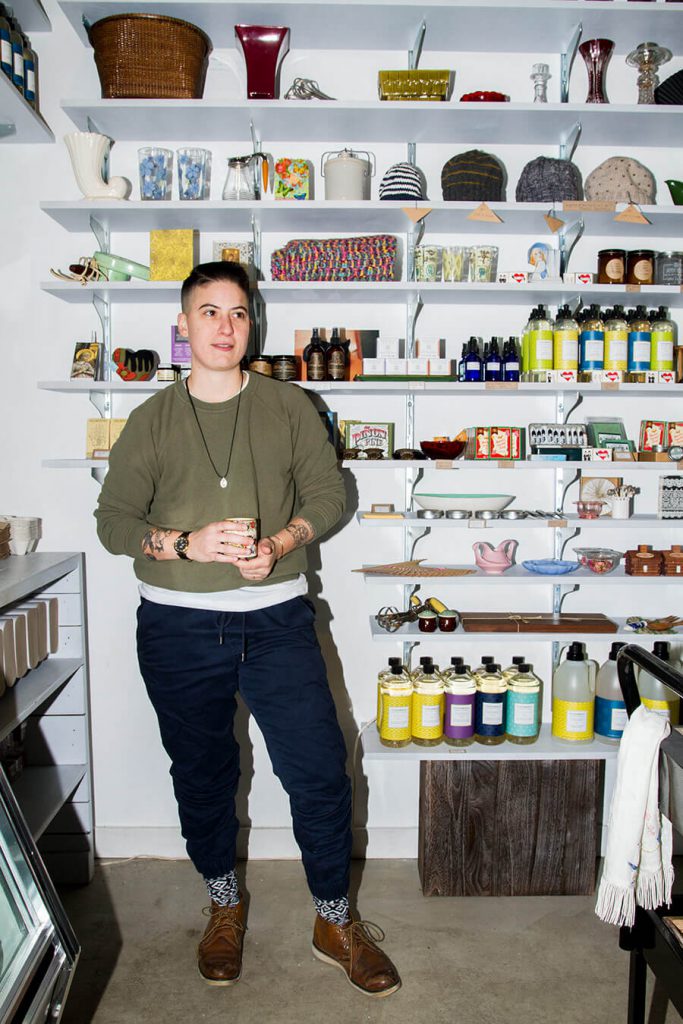
How do you teach someone to be willing to step outside their comfort zone?
The stakes are especially high when you are doing this all within the context of a startup business. Daniel, at the end of the day, is an owner of a start-up. He was taking a personal and professional risk. I don’t know how I did it, but it helps when the person you are trying to bring into the fold is already a mensch. Daniel is a CIS-straight mensch, which means he has blind spots. But everyone has their blind spots and some people are truly decent. You can pass on some of the things you know without feeling like you’re teaching because teaching is a literal job. You can expose folks to the world you live in and if they rise to that occasion, there isn’t as much labor involved. He rose to the occasion. It wouldn’t have worked if he was like, wait, there’s more than two genders?! That would have been me being like thanks for the experiment; I wouldn’t have been compelled to convince someone of that. Thankfully whenever he had questions they weren’t preposterous questions. Thy were questions I thought were appropriate and fair. I didn’t feel alienated.
Speaking of blind spots, there is a clear lack of visibility amongst trans people in retail and fashion. How can designers keep trans people in mind?
I won’t pretend that I know what it is like to be a designer. I don’t participate in that industry. Designers have an opportunity to do real design work—they’re supposed to be inspired and visionary and expansive in their perspectives. They are supposed to be able to do just about anything as there are infinite bodies to put clothes on. That should be exciting to them, not daunting. Designers should try going outside of their own comfort zones in regards to making garments. They should make garments that fit bigger bodies or smaller bodies than they are used to… although bigger bodies are probably more accurate. There is a lot to be said for how you present your designs. Again I’m not a designer, but I do understand presentation. If you design something you can put it on anyone—you don’t need to be working within any confines.
Being able to put garments on any type of person is such a beautiful thing. If you design something masculine, it doesn’t need to go on a man. I know that designers do experiment with this, but it doesn’t need to be a gimmick. I think there is a way for them to do that without honoring the same folks we always honor or recycling the same kind of imagery we always use by putting it on someone who is trans. We can do better. By taking something feminine and putting it on a trans woman, you’re not doing anything revolutionary. Sizing is the real key. Designers have a different rubric for what they are doing; I don’t know what theirs is, but I know what ours is when we are designing custom clothes which is just to design something for one person. I don’t know what the vision is when you are designing a line of clothes. We design something that comes in one person’s size.
Tell me about the first time you tried on a suit that fit the way you envisioned.
For me, in 2010, putting on a garment that was appropriately cut for me, meaning the pants were the right length, the jacket was the right length, and the silhouette mirrored my actual body—I always say this, but I never get tired of it…it introduced me to my body. We all have different ways of introducing ourselves to our bodies. It doesn’t have to be custom suits, I get that. For me that was the crossover where I thought oh my god, I have been mistreating this body all along. Not just with clothes, but with everything. We all have these moments, we don’t get to choose what our portal is to them, mine happened to be a custom suit. I went home and looked at all the clothes I owned and realized they were all hiding me. I decided to try harder to try and find clothes that didn’t do that. It changed my perspective on self expression and self care. Realizing that those things are directly linked to how I participate in my own life and how I feel present. Now I feel substantially more present. I think anyone could benefit from that.
Sitting here you seem very present. How’d you get there? Do you have daily self-love or self-care routines?
I am present. Being present for me has been more a force of habit than anything. Even when I’m having bad moments in terms of my relationship with how I look or feel, I’ve gotten so used to being present that I can’t exactly stop. While I don’t really have habits of self-care exactly, I know what it feels like to not do those things. It’s more just having perspective on having a lack of those things rather than actually engaging in them on a daily basis. Right now you got me at a moment where I’m like, I don’t do that. Self love? Every day? Who has time for that?
I love other people every day. That’s more valuable to me. I just happen to be in a moment where I’m not prioritizing myself and I don’t know why. I used to have things that I did and I’m sure I’ll do them again.
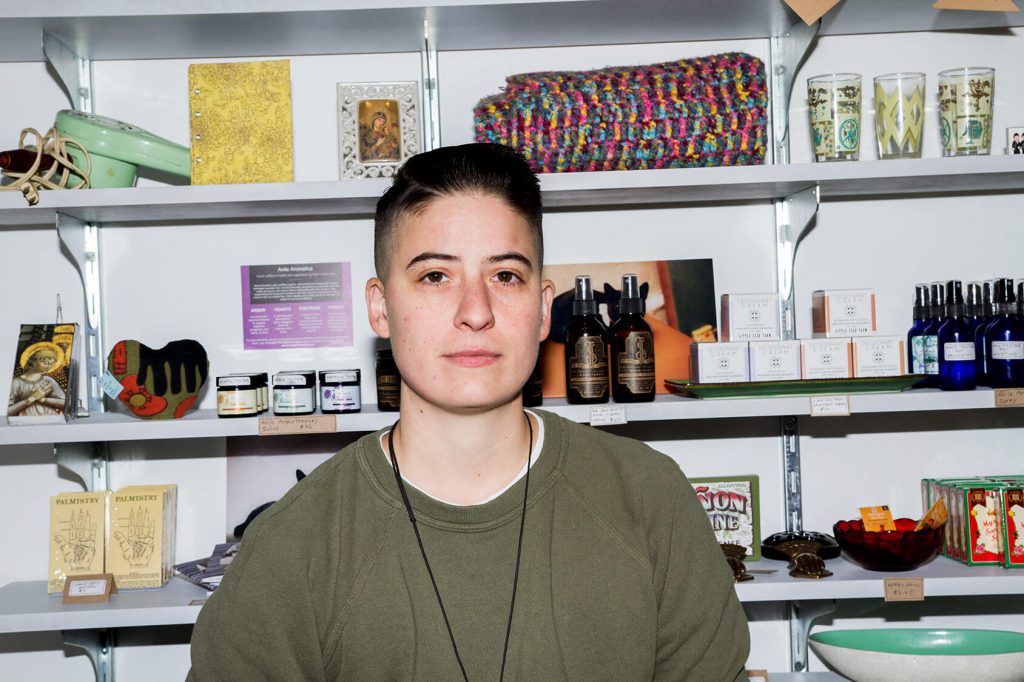
Do you still struggle some days?
I’m almost always present now. I grew up dissociating a lot of the times. Not just because of my gender but I got into this sort of pattern of dissociation as a kid. I never really stopped because I became so good at it. Whether or not I love my body or myself every minute, to be present is the real goal. I don’t have to love myself or my body every minute. That’s not possible. When I lose my sense of presence, I’m still doing a really good impression of myself. I’m still my own mouthpiece. I’m not lost. I’m still here. I’ve experienced not being here. Not being my own mouthpiece, just a total disconnect from myself and everyone else around me, so I know that I’m doing the best that I can.
You’ve put in the work.
It’s mandatory work for everyone, but the mandatory work is made more obvious when you are a trans person or a black person or when you are someone who society meditates on whether or not you are really a full person almost everyday. There is more urgency to do that work. It’s still everyone’s job.
How has your personal life and career politicized you? Were you as politically active in the past?
This is something that a lot of millennials experience. When you practice advocating for yourself, that lends itself very easily into advocating for others. I didn’t grow up with any models of activism or advocacy in my family. I came of age around September 11 in New York so from the beginning of being a teenager I was participating in anti-war and anti-capitalism protests. I went to a Jesuit college and did a lot of social justice work there. It’s always been a current that runs through my life. As I learned to advocate for myself, or started to feel situated enough in myself, I could invest that energy into advocating for other people. Now advocating for others feels like advocating for myself, kind of like switching sides. It’s a natural instinct that people who care about other people have. There is a place for people to do that in a professional way and a place for people to do it in a more personal way—just being an active part of your community, saying we have a right to be here, and we’ll always be here. Reminding people of that in any capacity feels very natural. It doesn’t matter how many people are paying attention to that message as long as a single person sees it.
What’s next for Willoughby General and Bindle & Keep?
Two things. One associated with each business I’m in. With Bindle & Keep, we’ve gotten to a point where we can give away free suits to people who are doing the hardest work of advocating for our community, or who have suffered in some way because of the discriminatory attacks on our community. We’re hoping to get to a point where we can do a pay it forward system where if a client has a means to keep getting suits for the work that they do, then we ask them if they want to make a donation toward a fund that subsidizes suits for other folks. Hopefully we’ll get there soon. Right now we are subsidizing suits for people like Gavin Grimm. People from the Innocence Project who were wrongfully convicted of crimes they didn’t commit and are trying to rebuild their lives and get a grasp on their own dignity. It’s exciting. I always said I wish I could give these suits away, and now I’m actually doing it.
Willoughby General I’m excited about because Barbara and I are realizing that one of the things that makes us special is the intergenerational relationship she and I have. The fact that I’m queer and she’s an ally, a cool babe, we are leaning into that. We are not just a general store, we can really be a community space, too. We are partnering with Word Bookstore so we can get books into the space and trying to find more ways to invite people into the space, not necessarily to buy things but to participate in feeling that there is a resistance.
All photos by Jane Bruce
You might also like 









